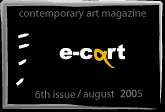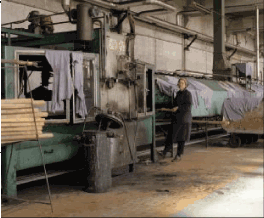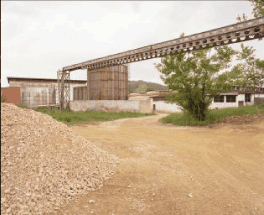| |
|
||||||||||||||||
| |
 |
|
|
||||||||||||||
 |
 |
 |
|
||||||||||||||
 |
|
|
|
||||||||||||||
| |
|
||||||||||||||||
 |
 |
 |
|
|
|||||||||||||
 |
|
||||||||||||||||
 |
 |
|
|
||||||||||||||
| |
 |
|
 |
 |
|
|
|
|
|||||||||
| |
|
||||||||||||||||
| |
|
||||||||||||||||
 |
|
||||||||||||||||
 |
|
||||||||||||||||
| |
|
||||||||||||||||
 |
|
||||||||||||||||
 |
|
||||||||||||||||
 |
|
||||||||||||||||
| |
|
||||||||||||||||
| |
|
|
|
|
|
|
|
|
|
|
|
|
|
|
|
|
|
The Site of Production: Live from Sarajevo
By Kim Dhillon
In May 2005, Maja Bajevic returned to Sarajevo to make a new process-based commission referencing the leather craft industry in Visoko, a town twenty kilometers north west of the capital of Bosnia and Herzegovina. In the 1980s and 1990s, the area was known as the economic stronghold of the former Yugoslavia because of its exports from the textile industries and leather tanning trade. Ten years after the peace accord which founded this small Balkan nation, the economic infrastructure has still not been rebuilt and renewed competition from foreign businesses has meant that the traditional local leather craft and textile industries have suffered massive job losses.
In this piece, Bajevic worked together with leather traders, skilled craftsmen, a team of leather sewers and former workers from Visoko's struggling KTK leather tannery. For five days, culminating on 22 May 2005, Maja Bajevic and her team worked to sew 210 square meters of leather around a house in Sarajevo, just outside of Bascarsija, the old Turkish quarter. Visible from the steep hill leading to the centre, busloads of locals, city transport workers and passers-by witnessed this temporary new work that resembled a bizarre, if contemporary fairy tale, a warning about the evils of globalisation. From a distance, the house looked liked a chocolate brown, life-size object from Hansel and Gretel. Up close, the craftsmanship was apparent in the perfect seams between enough leather to cover the surface of three lanes of an Olympic size swimming pool. The architecture of the house was typical for Bosnia: a square building with a four-pitched roof and flat eaves. Encased in red-brown leather, skillfully sewn together in a Sarajevo atelier, the house took on an absurd function. It was protected by a shelter more fragile than the house itself. The leather hides had been tanned and coloured a shade of burgundy and were sewn together in large squares. This was a high quality leather normally used for handbags and it had a bright sheen that glistened in the hot May sunshine. The structure did not to wrap the house like a Christo sculpture, but was constructed as a second shell around the building. Drain pipes poked out from the leather roof and snaked down the brown wall; exterior fuse boxes had square leather pouches sewn around them.
Four men had sewed the leather for the better part of a week to create the piece. On 21 May, it was brought from the atelier to the site and over the course of a day, assembled in eight large panels (one for each wall, one for each section of the roof) over the house. Without regard to any restrictions for health and safety or practicalities that would have burdened such a project if it were to happen in the UK, the men worked without scaffolding. Cigarette packs were stored temporarily among telephone wires on the roof for easy-access on the frequent breaks. (And there were many. Work in Bosnia inevitably gets done, but at a relaxed crawl). With a simultaneous dry humour, irony and the subtle suggestion of political meaning beneath the surface, Bajevic's project drew attention to the socio-economic questions facing the region nearly ten years after the Dayton Peace Agreement. The massive job losses in this region now give little concern to people outside Bosnia nor does their plight gain economic support from the international community who backed the peace.
The turmoil of the international textiles trade has recently been at the forefront of international press. Historically textiles is an industry that has acted as a catalyst for industrialisation, kick-starting the economies of many developing nations. Textiles is a market whose demand is endlessly expanding with the high-turnover of the fashion industry and textiles factories have consistently provided thousands of jobs in both developed and developing nations. This industry, however, is increasingly dominated by China, where dress production is up 600%, T-shirt production up 328%, and trouser production up from 31 million to 240 million in the first quarter of 2004. Meanwhile jobs in other parts of the world are under threat where they cannot compete with China's low economic costs and scale of production. Neil Kearney, secretary general of the Brussels-based International Textile, Garment, and Leather Workers Federation says: "I think it is no exaggeration to say that China has hijacked the world market in textiles and clothing."
The European Union and the United States have the support of the World Trade Organisation to pressure China to raise its exports tariffs on textiles in an attempt to protect jobs in the States and in hard hit European nations like Greece and Portugal or Slovenia, another nation established after the break up of Yugoslavia. Bosnia and Herzogovina however lies outside the protection of the EU and without the support of the international community for the nation's redevelopment, its textiles workers, traders, and employers are left to fend for themselves in a losing battle within this global textile market. In this situation which is typical of modern globalisation, local political manipulation is often indistinguishable from the control mechanisms of larger economic systems and global markets. Bajevic views the situation as a "new colonialism," involving the domination of several states by capitalism without regard to levels of skills in the workforce or local economies which had established ties to particular traditions in craft. In this situation, governments are powerless to intervene and can only provide remedial measures. Ten years after the Dayton Peace Agreement, Bajevic's new project explores the repercussions of transition from State socialism to free market capitalism. Bajevic's new work could easily make sense in Lesotho, South Africa, where 20,000 jobs in textiles have disappeared since January 2005, or Dhaka, Bangladesh, where it is feared nearly a million jobs will be lost (half the Bangladeshi textiles industry workforce) in the near future as production shifts further into East Asia with the increasing domination of China's textile industry. Lenin's old question, "What is to be Done?" suggests that there exist other possibilities, often more subtle and perhaps with longer effects, than straightforward protest to raise awareness or seek change.
The starting point for Bajevic's new project was the workers at KTK, a tannery and leather garment factory in Visoko. On the factory site there are three main buildings: two are completely derelict and abandoned, leaving thousands of square feet of industrial space wasted as a direct consequence of the war. KTK now runs at a tenth of its pre-war capacity but in 1985, KTK was producing 100,000 square meters of leather a year ready for export, with staff working in round-the-clock shifts of three hundred in order to meet demand. When Bajevic and I arrived at the tannery to film the colouring of the last of our order of leather, only a handful of workers were on site to complete the job. Those still employed now come in only when they are needed. To get to the toilet in the factory, you must cross through two massive empty wings of the factory. The large canteen looks abandoned: its rows of tables and chairs deserted. Adjacent rooms sit full of machinery that have fallen into a state of disrepair. In its redundant state, the massive machinery presses - the size of two skips - take on a sculptural form. They have conveyor belts and steamers that could dwarf those seen in broadsheet printing factories. The emptiness of the place is made most apparent by the silence. KTK is a quiet place lacking the drone of white noise typical of a busy industrial site. Less than twenty metres away, a major new building is under construction. An Italian leather garment manufacturer is establishing a new factory, which is likely contribute a final blow to the plant and which may lead to the eventual closure of KTK. This new factory with modern machinery is not obliged to employ anyone from KTK, many of whom had been with the company for more than thirty years; nor is it tied to the local tradition of tanning in the way that KTK was; and all its leather will be produced as raw material for export, further reducing the effect on the manufacturing base of the region.
Bajevic's new work, however, is more focused on process than end product. The piece was shown as a projected video and documentary photos in London in June 2005; both forms were intended to translate and give permanence to the unfolding process of producing the house. The project exists as a narration upon her collaboration with the craftsmen, factory workers and local tradesmen. The object produced, the house, is not the "artwork" only the documentation of the processes by which the structure was made: the negotiations, plans, labour and relationships built. This process in turn, forms the core of Bajevic's ongoing concerns with the impact on individuals of both the economic repercussions and failures of this new state. Bajevic's work consistently remains grounded in this reality. It is never hysterical despite the traumatic political situations it often questions.
In 2003, Bajevic was one of the four artists to represent Bosnia and Herzegovina when it participated for the first time with a national pavilion at the Venice Biennale. In the exhibition catalogue, the curator, Asja Mandic, wrote: 'Maja Bajevic's works express the trauma of war in a post-war environment of disintegrating values, poverty, and social instability, where the common man is swamped under the weight of social and political change and manipulation.' She continued: 'Maja Bajevic feels a responsibility as an artist to mirror reality directly. Her works communicate about what used to be, what is now felt, and what is sometimes forgotten, ignored, and pushed to the margin.'
While she identified Bajevic's work as politically charged, autobiographical, and emotional, Mandic commented that her art was both an 'act of resistance and social criticism, as well as a healing agent.' While this is true of her work several years ago, she has now moved beyond healing. Bajevic's new work challenges social criticism not to heal, but to question, push, and disturb the bottom line.
Kim Dhillon is a curator and writerliving in London.
A full version of this article was originally published in English under the title 'The Site of Production: Maja Bajevic's New Work in Sarajevo' in the May/June 2005 Families/Homilies issue of n paradoxa